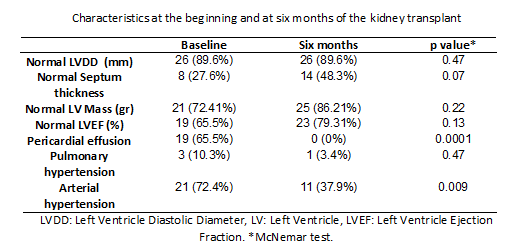Morphological and Functional Changes of the Heart Six Months after Renal Transplantation
Dorian Toledo1, Manuel H. Toledo1, Luis C. Barrios1, Rudolf García-Gallont1, Michaelle Toledo1.
1Nephrology and Renal Transplantation, San Juan de Dios General Hospital, Guatemala, Guatemala
Introduction: Chronic kidney disease add a syndrome that affects most organs and systems, including the heart. This study was undertaken to describe the changes in the morphology and functioning of the left ventricle of the heart, six months after the kidney transplant.
Materials and Methods: Echocardiographic findings of 29 patients were compared before and six months after renal transplantation.
Results: The average age was 29.7 years. 58.6% were males. At six months, the glomerular filtration rate and serum hemoglobin increased, while the systolic and diastolic blood pressures decreased (p <0.0001). Echocardiographic measurements showed a decrease in diameter and ventricular mass, thickness of the septum, and an increase in the ejection fraction (p <0.0001). Nineteen patients who had previous pericardial effusion, had completely resolved by 6 months. Of three patients with pulmonary hypertension, only one persisted after six months. Arterial hypertension decreased importantly in almost half of the patients. Patients that normalized ejection fraction six months after transplantation, had been less time in dialysis than patients whose outcome was abnormal at the end of our study (p 0.01).
Discussion: In this study it was found that, six months after the kidney transplant (TR), there were significant changes in the morphology and function of the heart, according to the echocardiographic evaluation. These changes are important, since they translate into better cardiac function, probably increasing the survival of these patients. The improvement in blood pressure, as well as the disappearance of the pericardial effusion also help to reduce cardiac overload.
Conclusions: In the patients who received renal transplantation, improvement was found in the diameter of the left ventricle, in the thickness of the septum, left ventricular mass and the ejection fraction of the left ventricle. We found a possible association between the times of dialysis treatment prior to renal transplantation, with the improvement of the ejection fraction of the left ventricle.


